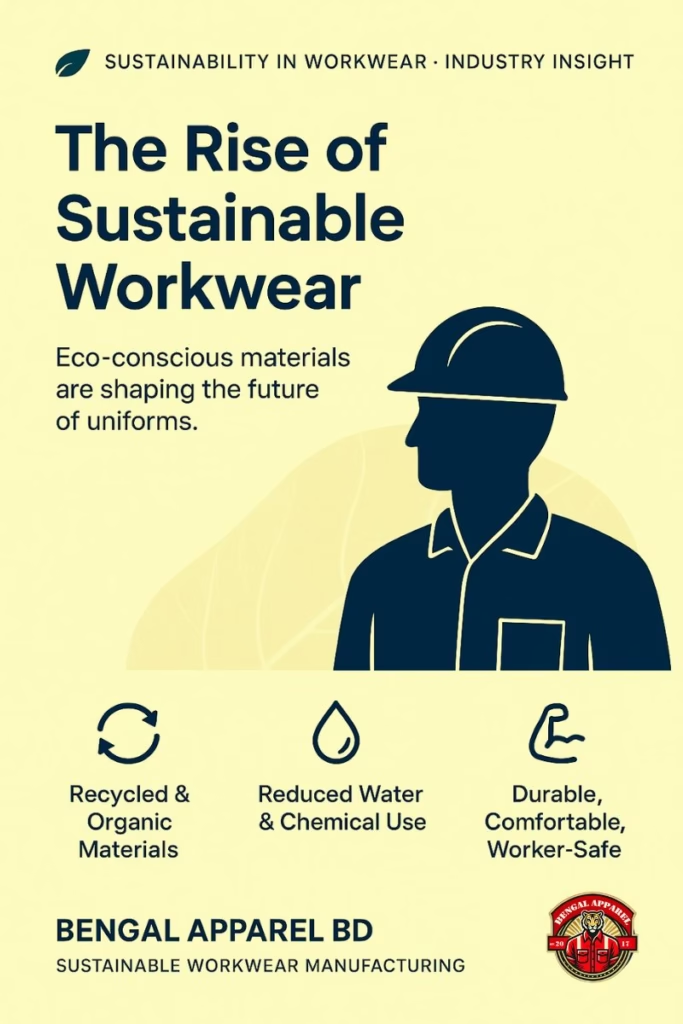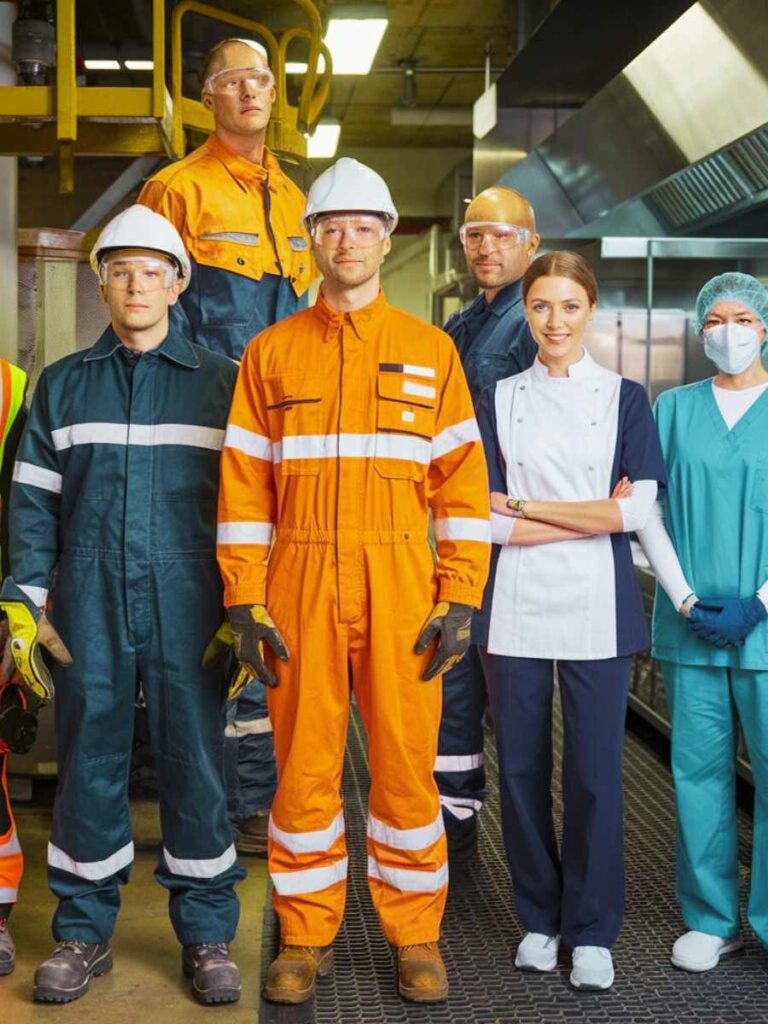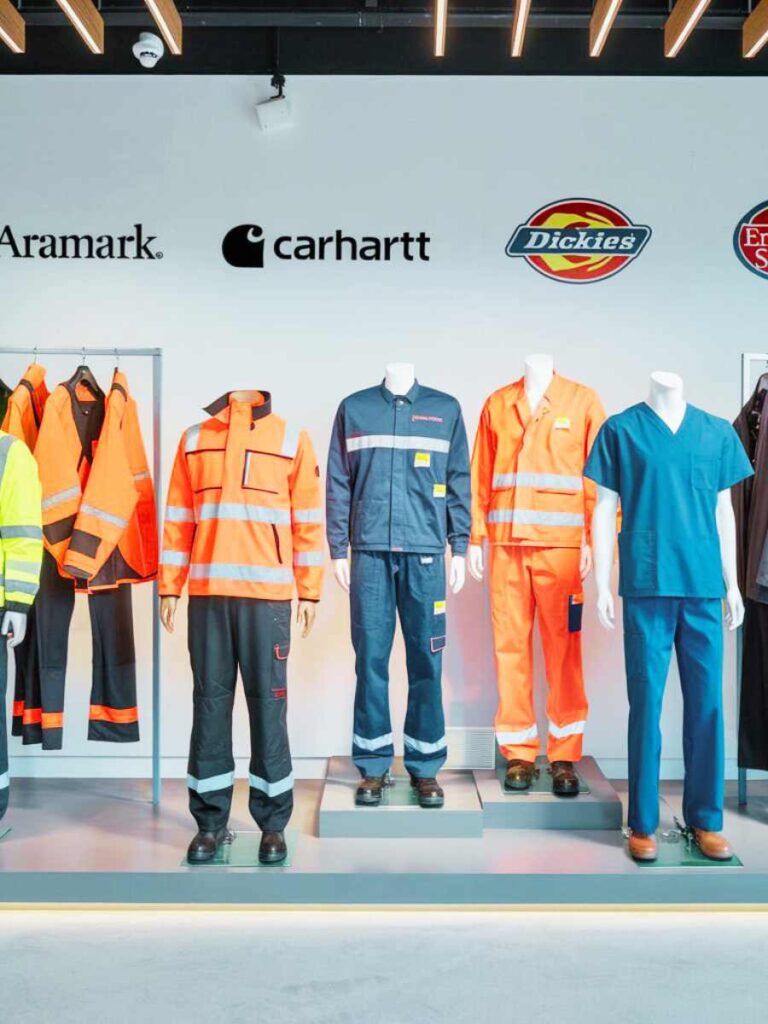The global workwear industry is undergoing a major shift. For decades, manufacturers focused on producing durable and affordable uniforms, often overlooking their environmental impact. Today, that mindset is changing. Sustainable fabrics in workwear are no longer niche alternatives—they are becoming the new industry standard.
The workwear market, valued at USD 19.08 billion in 2024, is projected to reach USD 30.60 billion by 2033. One of the strongest drivers behind this growth is the rising demand for environmentally responsible materials and manufacturing practices. Businesses, workers, and consumers alike increasingly recognize that the clothing we rely on every day should protect not only people—but the planet as well.
Why the Shift Toward Sustainable Fabrics in Workwear Matters
Traditional workwear comes with a significant environmental burden. For example:
Producing one cotton T-shirt requires around 2,700 liters of water.
Conventional cotton farming uses heavy pesticides, which harm the environment and workers.
The global textile industry generates 92 million tons of waste annually, much of which ends up in landfills.
Workwear made from synthetic fibers like virgin polyester can take hundreds of years to decompose.
Chemical dyeing and finishing processes also contaminate rivers and soil, impacting surrounding communities and ecosystems. In fact, the UK House of Commons Environmental Audit Committee has identified the textile industry as one of the most polluting sectors in the world.
The need for more responsible choices has become impossible to ignore.
Breakthrough Materials Changing the Landscape of Workwear
The rise of sustainable fabrics in workwear is fueled by innovative materials that maintain, if not enhance, durability and performance..
Organic Cotton
Organic cotton is grown without synthetic fertilizers or pesticides.
Benefits include:
Reduced water usage
Healthier soil and farming conditions
Soft, breathable comfort for the wearer
This makes it ideal for uniforms in sectors like hospitality, healthcare, and light-duty labor.
Recycled Polyester (rPET)
Recycled polyester is made from post-consumer plastics such as bottles and discarded fishing nets.
It offers:
High durability
Resistance to tearing and staining
Reduced dependence on petroleum
This material is widely used in heavy-duty workwear, construction uniforms, and industrial apparel.
TENCEL™ (Lyocell)
Produced from sustainably managed wood pulp, TENCEL™ uses a closed-loop process, meaning nearly all water and chemicals are reused.
Key advantages:
Excellent moisture-wicking
Breathable and lightweight
Ideal for warm climates and physically demanding jobs
Hemp
Hemp grows quickly without pesticides and requires far less water than cotton.
It is:
Strong
Long-lasting
Suitable for reinforced and rugged workwear
Bamboo Fiber
Bamboo regenerates rapidly and requires no chemical fertilizers.
Notable features:
Naturally antibacterial
Breathable and soft
Commonly used in healthcare and active work environments
Industry Example:
Brands like SYNQ Workwear report that 75% of their fabrics now contain recycled or eco-friendly fibers, proving sustainability and performance can go hand-in-hand.
How the Workwear Market Is Evolving
The shift toward sustainable fabrics in workwear is not just driven by environmental awareness—it’s also becoming a competitive business advantage.
Manufacturers are now designing garments that last longer, reducing waste and replacement costs.
Bangladesh, a global leader in textile manufacturing, is investing in waterless dyeing technology, renewable energy, and efficient factory systems.
Major brands like VF Corporation (owner of Dickies) and Fristads Kansas Group are expanding their eco-friendly product lines in response to customer demand.
Research shows that extending the lifespan of work clothing by just nine months can reduce its environmental footprint by 20–30%. Durability is no longer just a performance requirement—it is a sustainability strategy.
You may also read: Sustainable Workwear Bangladesh
Sustainability Goes Beyond Fabric: The Full Supply Chain Matters
Choosing eco-friendly fabrics is only part of the solution. True sustainability in workwear involves improving every step of the production process.
Key Areas of Progress:
| Sustainability Area | Example Practice |
|---|---|
| Manufacturing | Low-water dyeing, energy-efficient production |
| Labor Practices | Fair wages, safe conditions, ethical sourcing |
| Packaging | Recycled poly bags, recyclable cardboard |
| Certifications | GOTS, GRS, OEKO-TEX, Fair Trade, Sedex |
These third-party certifications help businesses verify the environmental and ethical integrity of their supply chains.

Benefits of Sustainable Workwear for Businesses and Workers
Switching to sustainable fabrics offers meaningful advantages:
For Businesses
Lower long-term replacement costs due to enhanced durability
Eligibility for sustainability grants and incentives
Stronger brand reputation and customer trust
For Employees
Reduced risk of skin irritation from harsh chemicals
Improved comfort due to breathable and moisture-wicking fabrics
Potential for better well-being and job satisfaction
In a competitive market, companies committed to sustainability stand out—and attract talent, customers, and partners who value ethical responsibility.
Looking Ahead: The Future of Sustainable Fabrics in Workwear
Sustainability is rapidly becoming the baseline standard, not a premium feature. As environmental regulations tighten and consumer awareness grows, businesses that fail to adopt sustainable practices risk being left behind.
Emerging innovations include:
Biodegradable synthetic fibers
Regenerative farming for natural textiles
Recyclable garment systems that support circular production
The rise of sustainable fabrics in workwear is more than a trend—it is a transformation of how we protect workers and the planet at the same time.
FAQs About Sustainable Fabrics in Workwear
1. Are sustainable workwear fabrics as durable as traditional materials?
Yes. Many sustainable fabrics, such as recycled polyester and hemp, are equal to or stronger than conventional fibers.
2. Do sustainable uniforms cost more?
Initial costs may be slightly higher, but longer garment lifespan reduces total replacement expenses over time.
3. How can businesses verify sustainability claims?
Look for certifications like GOTS, OEKO-TEX, Fair Trade, and GRS.
4. Which industries benefit most from sustainable workwear?
Construction, healthcare, hospitality, manufacturing, transportation, and logistics are leading adopters.
Conclusion
The shift toward sustainable fabrics in workwear reflects a deeper understanding: protecting people and protecting the planet are interconnected goals. By choosing environmentally responsible materials, businesses support worker health, reduce waste, enhance brand value, and contribute to a more sustainable future.
The question is no longer whether to adopt sustainable workwear—but how soon organizations will take the next step to stay competitive and responsible.




